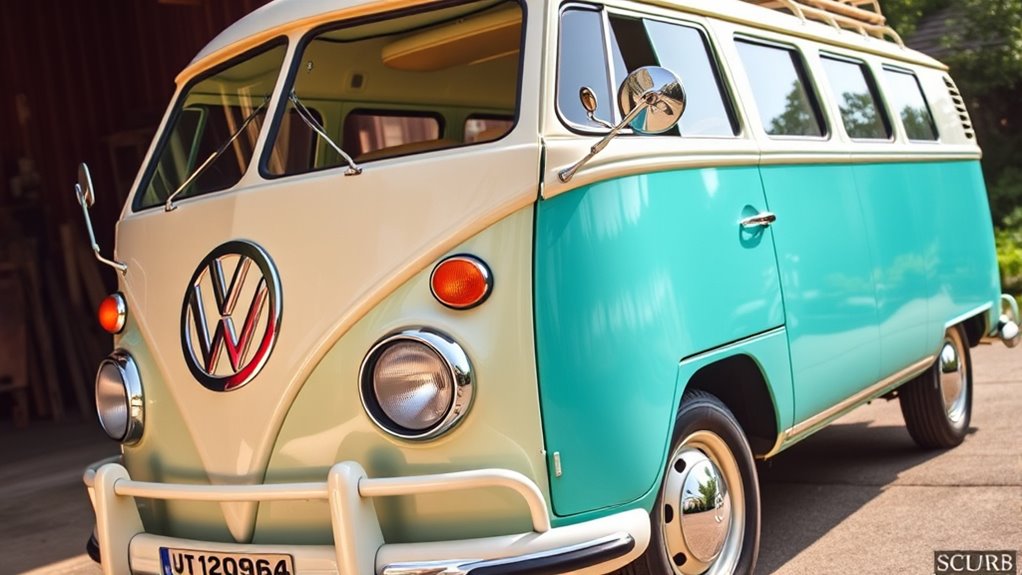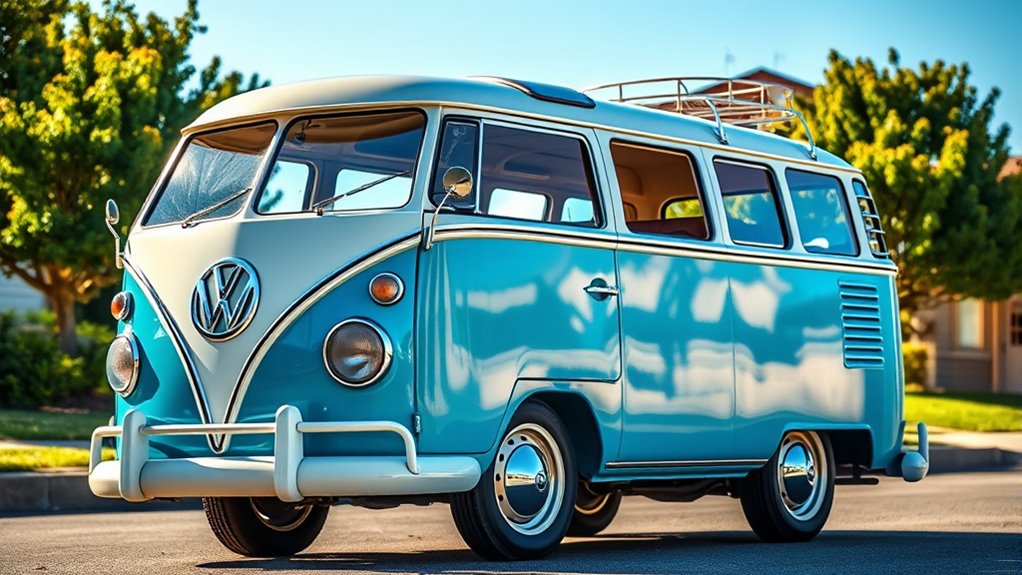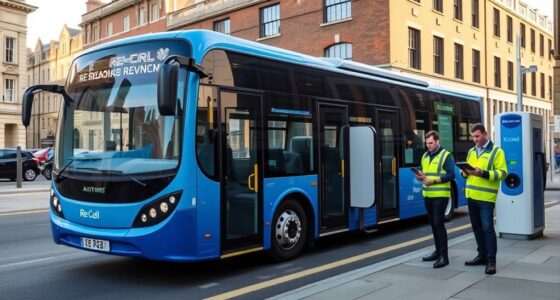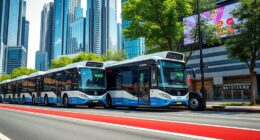Transforming a barn-find VW Bus into a dependable daily driver takes patience, careful planning, and attention to detail. Start with a thorough inspection to prioritize safety and structural repairs, then organize parts and tools for smooth progress. Focus on bodywork, sourcing authentic parts, and meticulous mechanical rebuilding. Reassemble with precision and test drive to fine-tune. If you keep at it, you’ll discover the satisfying process of bringing this vintage icon back to life, ready for daily adventures.
Key Takeaways
- Conduct a thorough inspection and create a detailed plan focusing on safety, rust repair, and structural integrity.
- Organize parts and tools, then disassemble and clean components, assessing each for restoration or replacement.
- Perform bodywork with authentic paint, natural materials, and attention to vintage details to preserve character.
- Source OEM or reproduction parts through forums and clubs, replacing worn components for reliability.
- Carefully reassemble, test drive, and fine-tune to ensure the VW Bus functions reliably as a daily driver.

Restoring a vintage VW Bus is a rewarding project that combines craftsmanship with nostalgia. When you decide to bring a forgotten barn find back to life, you’re taking on a journey that requires patience, skill, and attention to detail. The process of vintage restoration isn’t just about fixing what’s broken; it’s about preserving the character and charm that make these buses iconic. To make your project smoother, it helps to gather some DIY tips early on. These tips will guide you through the complexity of restoring a classic vehicle, especially if you’re new to this type of work.
Restoring a vintage VW Bus blends craftsmanship, nostalgia, and patience for a rewarding journey.
First, assess the condition of your VW Bus thoroughly. Look for rust, frame damage, and the state of the engine. Document everything with photos and notes so you can create a clear plan. Once you understand what needs fixing, prioritize tasks based on safety and structural integrity. For example, rust repair and frame reinforcement should come first, as they’re essential for the bus’s safety and longevity. When it comes to vintage restoration, patience is key—some parts may need custom fabrication or sourcing from specialty suppliers. Don’t rush the process; taking your time ensures quality work and prevents costly mistakes.
A critical DIY tip is to keep organized. Use labeled containers for parts and tools, and create a step-by-step plan. This way, you won’t get overwhelmed, and you’ll be able to track your progress easily. As you strip down the bus, clean every part thoroughly before reassembling. This is the perfect time to evaluate what can be restored, repaired, or replaced. When working on the body, sandblasting and rust treatment are essential steps to prevent future corrosion. If you’re handling paint, choose a high-quality automotive paint that matches the original color to keep that vintage look authentic. Incorporating natural materials like wood accents and linen upholstery can further enhance the vintage aesthetic while maintaining durability.
Don’t forget the importance of sourcing the right parts. Many vintage restoration enthusiasts find that joining online forums and local clubs can connect you with suppliers and fellow restorers who share tips and even spare parts. When rebuilding the engine and mechanical components, stick to OEM or high-quality reproduction parts for reliability. Replacing worn-out bushings, seals, and gaskets is a DIY task that can save you money and ensure the vehicle runs smoothly.
Finally, as you reassemble the bus, take your time to ensure everything fits perfectly. Test drive once it’s back on the road, and make adjustments as needed. Restoring a VW Bus from barn find to daily driver is a labor of love, and each step brings a sense of accomplishment. With patience, proper planning, and these DIY tips, you’ll enjoy not just the process but the pride of cruising in a vintage vehicle you brought back to life.
Frequently Asked Questions
What Was the Original Color of the VW Bus?
You might wonder what the original color of the VW bus was. During the vintage paint and color restoration process, it was revealed that the bus’s initial hue was a classic pastel blue. Restoring this original shade involved careful matching and refinishing, bringing back its nostalgic charm. Your restoration efforts focus on preserving the vintage paint, ensuring the bus maintains its authentic look while becoming a reliable daily driver once more.
How Many Hours Did the Restoration Process Take?
You’re curious about the restoration timeline and labor hours involved. Typically, restoring a VW bus takes around 150 to 200 labor hours, depending on its condition and level of detail. This process can span several weeks or months, as you carefully disassemble, repair, and reassemble the vehicle. Your dedication guarantees each step is done thoroughly, transforming the bus from a barn find into a reliable daily driver.
What Specific Challenges Were Faced During Restoration?
Imagine peeling back layers of history—restoration setbacks can feel like uncovering hidden traps. You faced sourcing parts, which proved tricky, delaying progress. Rust damage was worse than expected, requiring careful welding and patience. Finding authentic components tested your resourcefulness, and unexpected mechanical issues cropped up mid-project. These challenges kept you on your toes, but ultimately, perseverance transformed setbacks into a beautifully restored VW bus, ready for the open road.
Was Any Modern Technology Added to the Bus?
You’ll find that modern upgrades were added to preserve the vintage appeal while enhancing functionality. For example, you might include a Bluetooth stereo or LED lighting to improve comfort and convenience. These modern technologies blend seamlessly with the classic look, allowing you to enjoy the nostalgic charm of the VW bus while benefiting from contemporary features. It’s a perfect balance between vintage appeal and modern upgrades, making your drive more enjoyable.
How Much Did the Entire Restoration Cost?
Think of restoration budgeting as shaping a sculpture from raw stone—you’ll carve carefully to balance costs and quality. For your VW bus, expect expenses to fall within a range influenced by vintage car valuation and desired upgrades. Overall, restoring it could cost anywhere from a few thousand to over ten thousand dollars, depending on parts, labor, and features added. Planning wisely guarantees your project stays within budget while preserving its charm.
Conclusion
As you watch this VW bus shift from forgotten relic to vibrant road companion, you realize it’s more than just restoration — it’s a rebirth. Every dent and rust spot tells a story, now rewritten with new life and purpose. This journey proves that with patience and passion, even the most abandoned can find their way back onto the open road. It’s a dance of time, turning memories into miles, and dreams into daily drives.









